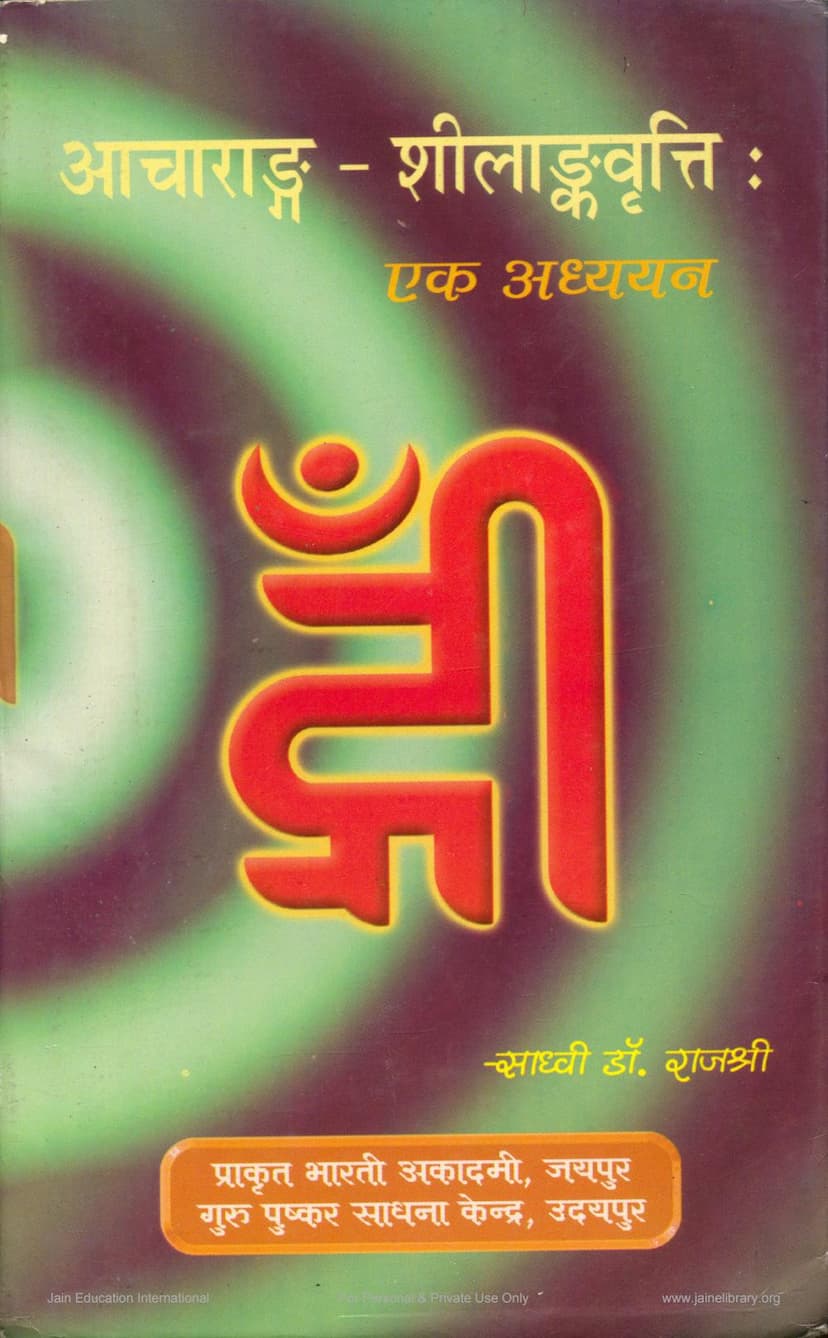Acharang Shilank Vrutti Ek Adhyayan
Added to library: September 1, 2025

Summary
Here's a comprehensive summary of the Jain text "Acharang Shilank Vritti Ek Adhyayan" by Sadhvi Dr. Rajshree, based on the provided pages:
Book Title: Acharang Shilank Vritti Ek Adhyayan (A Study of Acharanga with Shilanka's Commentary)
Author: Sadhvi Dr. Rajshree
Publisher: Prakrit Bharti Academy, Jaipur (in conjunction with Guru Pushkar Sadhana Kendra, Udaipur)
Overview:
This book is a scholarly study of the Acharanga Sutra, the first and most important text in the Jain Agamas, and specifically focuses on the commentary (Vritti) written by Acharya Shilanka. The study aims to provide a multi-faceted analysis of Shilanka's commentary, exploring its philosophical, cultural, and linguistic aspects.
Key Themes and Content:
-
Significance of Acharanga Sutra:
- The Acharanga Sutra holds the highest place in Jain Agamic literature.
- It is considered the most ancient text in the currently available Jain literature.
- It is believed that all Tirthankaras, past, present, and future, begin their teachings with the Acharanga Sutra.
- The text is paramount in Jainism because it deals with Achar (conduct or right conduct), which is essential for liberation. Without proper conduct, knowledge and philosophy become superficial.
- Acharanga defines the soul (Jiva) and establishes Ahimsa (non-violence) as the foundation of the path to liberation. It emphasizes sensitivity to the suffering of others as the basis for renouncing violence.
- The book highlights that Acharanga expounds on the distinction between the beneficial and the detrimental in life and offers concise yet precise sutras on all aspects of life, from the existence of the soul to liberation from the cycle of rebirth.
-
The Legacy of Commentaries on Acharanga:
- The text acknowledges the extensive body of literature dedicated to explaining the Acharanga Sutra's profound and comprehensive subject matter.
- It outlines the progression of these commentaries:
- Niryukti: Poetic explanations in Prakrit, primarily defining technical terms. Acharya Bhadrabahu (II) is credited with composing or compiling these.
- Bhashya: While Bhashyas followed Niryuktis, no Bhashya on Acharanga is currently known.
- Churni: Mixed Prakrit and Sanskrit explanations, expanding on the Niryuktis. Jinadas Gani is mentioned as the author, though this is not definitively confirmed. The Churni contains significant historical material.
- Tika/Vritti: As the influence of Sanskrit grew, Jain acharyas began writing commentaries in Sanskrit. These Tika/Vritti works incorporate material from Niryuktis, Bhashyas, and Churnis, offering new perspectives.
-
Acharya Shilanka and His Commentary:
- Acharya Shilanka is identified as the first Sanskrit commentator on the Acharanga Sutra. He is also known as Shilangacharya and Tatvaditya.
- According to Prabhavaka Charitra, he wrote commentaries on nine Angas, but scholars believe only the commentaries on Acharanga and Sutrakritanga are extant.
- His commentary on the first Shruta Skandha of Acharanga mentions the names Shilacharya and Tatvaditya, and sometimes just Shilank.
- The commentary's composition dates are given as Gupta Samvat 772 for the first Shruta Skandha and Shaka Samvat 784/798 for the second Shruta Skandha. Scholars generally equate Gupta Samvat and Shaka Samvat, placing the commentary's creation around Vikram Samvat 907-933.
- Shilanka's Vritti is based on the original text and Niryuktis, offering detailed discussions on each subject. Its language and style are easily understandable.
- Due to its insightful analysis, all subsequent writings on Acharanga are considered to be based on Shilanka's Vritti, making it the foundational text for understanding Acharanga.
-
The Present Study's Approach:
- The research paper by Sadhvi Dr. Rajshree is a critical study of Shilanka's commentary on Acharanga.
- It begins with an introduction to the Agamic literature and the significant position of commentaries within it.
- The study analyzes Shilanka's commentary from various perspectives, including:
- Philosophical: Examining the Acharanga commentary within the context of the foundational principles of Jain philosophy, considering the philosophical milieu of Lord Mahavir's time. This is covered in two chapters.
- Cultural: Investigating the various aspects of the culture of that era discussed by the commentator. The separate study of historical, religious, social, and political themes mentioned in the Vritti is noted as providing interesting information and a detailed account of social conditions and systems.
- Linguistic: While not a comprehensive linguistic analysis, it highlights information related to prose-poetry style and grammar, emphasizing the commentary's clarity, flow, and accessibility.
- The study concludes with the commentator's (Shilanka's) discussion on conduct, which is the primary theme of the Vritti.
- The inclusion of brief introductions to famous commentators on the Agamas enhances the book's value as a reference work.
-
Author's Journey and Inspiration:
- Sadhvi Dr. Rajshree attributes her journey into rigorous academic study to the inspiration and encouragement of her Guru, Sadhvi Charitprabhaji Maharaj.
- She completed this research work in the state of vairagya (renunciation) before taking her final vows and later earned her Ph.D. from Jai Narain Vyas University, Jodhpur.
- The preface mentions the significant role of the late Acharya Samrat Pujya Shri Devendramuniji Maharaj in encouraging the joint publication of this research work.
Structure of the Study:
The book is divided into several chapters, exploring the Acharanga Vritti from different angles:
- Chapter 1: Critical Study of Acharanga Vritti
- Chapter 2: The Subject Matter of Acharanga Vritti
- Chapter 3: Philosophical Study of Acharanga Vritti
- Chapter 4: Jain Dharma and Philosophy Expounded in Acharanga Vritti
- Chapter 5: Cultural Study of Acharanga Vritti
- Chapter 6: Linguistic Study of Acharanga Vritti
- Chapter 7: The Commentator's Discussion on Conduct
Overall Significance:
"Acharang Shilank Vritti Ek Adhyayan" is presented as a significant contribution to Jain Agamic scholarship. It aims to make the complex and profound insights of Acharya Shilanka's commentary on the foundational Acharanga Sutra accessible and understandable to a wider audience, including monks, scholars, and general readers interested in Jain philosophy, culture, and literature. The study is praised for its comprehensive approach and detailed analysis.